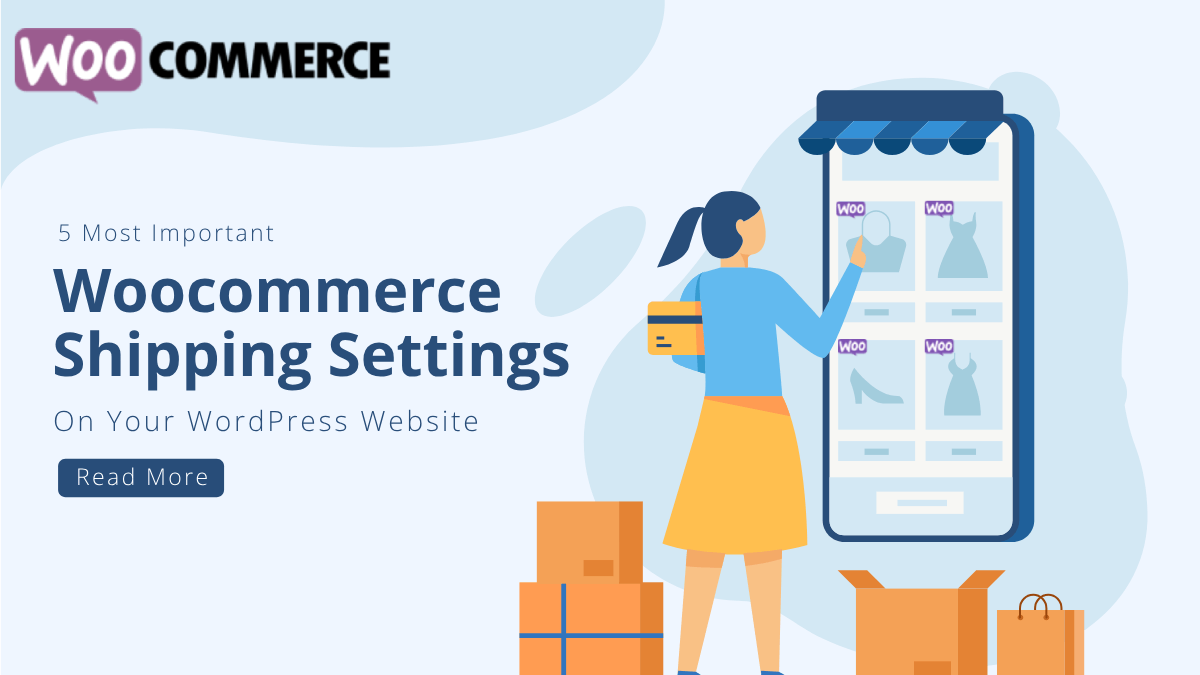Creating a seamless and efficient shopping experience for your customers goes beyond just a visually appealing website and quality products. The shipping process is one of the critical aspects that can make or break the online shopping journey. A well-optimized shipping strategy not only ensures customer satisfaction but also plays a pivotal role in the success of your online business.
If you’re running your e-commerce store on WordPress with WooCommerce, you’re already on the right track. However, to truly elevate your shipping game, it’s essential to dive into the intricate world of WooCommerce shipping settings. These settings act as the backbone of your shipping infrastructure, influencing everything from delivery timelines to cost calculations and customer expectations.
In this blog post, we’ll unravel the mysteries behind the 5 Most Important WooCommerce Shipping Settings on Your WordPress Website. Whether you’re an online retailer looking to fine-tune your shipping strategy or a budding entrepreneur stepping into the digital marketplace, understanding and optimizing these settings can significantly impact your bottom line. Get ready to unlock the potential of your e-commerce business by mastering the intricacies of WooCommerce shipping, ensuring smooth sailing for both you and your customers. Let’s streamline your shipping processes and take your online store to new heights.
What Is WooCommerce Shipping?
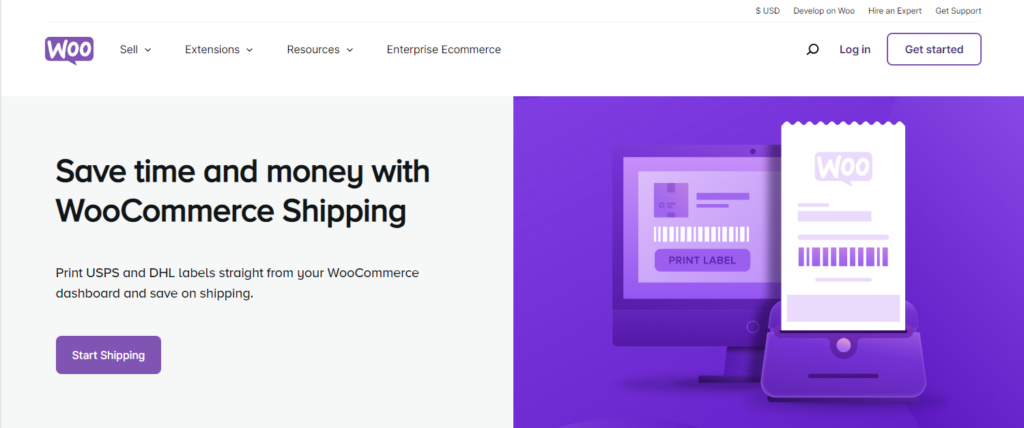
WooCommerce Shipping is a comprehensive shipping solution integrated into the WooCommerce WordPress plugins, specifically designed to simplify and streamline the shipping process for e-commerce businesses. It offers a range of features and settings that allow online retailers to efficiently manage shipping logistics, calculate shipping costs, and provide accurate delivery estimates to their customers.
At its core, WooCommerce Shipping works by providing merchants with a centralized platform within their WordPress dashboard where they can configure and customize various aspects of their shipping strategy. This includes setting up shipping zones, defining shipping methods and rates, managing shipping classes and dimensions, and handling international shipping.
One of the key components of WooCommerce Shipping is the ability to create shipping zones. Shipping zones allow merchants to group together geographical regions and define specific shipping methods and rates for each zone. For example, a merchant may create separate shipping zones for domestic orders, international orders, or even different regions within a country.
Within each shipping zone, merchants can configure various shipping methods such as flat rate shipping, free shipping, or calculated shipping based on factors like weight, dimensions, or destination. This flexibility allows merchants to cater to different customer preferences and shipping requirements.
Furthermore, WooCommerce Shipping allows merchants to set up shipping classes to categorize products based on their shipping characteristics. For instance, products with different sizes, weights, or shipping requirements can be assigned to different shipping classes, enabling more precise shipping calculations and rate adjustments.
International shipping is also made easier with WooCommerce Shipping, as merchants can set up specific settings and options to manage customs, taxes, and duties for international orders. This helps ensure compliance with international shipping regulations and provides a smoother experience for both merchants and customers
Significance Of WooCommerce Shipping Settings
The significance of WooCommerce Shipping settings lies in their ability to shape and optimize the entire shipping process for e-commerce businesses. These settings, integrated within the WooCommerce WordPress plugins, offer a range of customizable options that directly impact how merchants manage, calculate, and present shipping options to their customers. Let’s delve deeper into the significance of WooCommerce Shipping settings:
- Tailored Shipping Rates: WooCommerce Shipping settings allow merchants to set up customized shipping rates based on various factors such as product weight, dimensions, destination, and shipping method. This flexibility enables businesses to accurately calculate shipping costs, ensuring fair pricing for both customers and the merchant.
- Enhanced Customer Experience: By configuring shipping settings to provide accurate delivery estimates and transparent shipping options, merchants can significantly enhance the overall shopping experience for their customers. Clear shipping information builds trust and confidence in the purchasing process, leading to higher customer satisfaction and retention rates.
- Geographical Flexibility: With WooCommerce Shipping settings, merchants can create shipping zones tailored to specific geographical regions, allowing them to offer different shipping methods and rates based on customer location. This geographical flexibility enables businesses to cater to diverse customer bases and expand their market reach seamlessly.
- Streamlined Operations: Centralized management of shipping settings within the WooCommerce dashboard simplifies the shipping process for merchants. From configuring shipping methods to handling international shipping and managing shipping classes, having all shipping-related tasks in one place streamlines operations and saves time and effort for businesses.
- Cost Optimization: By utilizing WooCommerce Shipping settings effectively, businesses can optimize shipping costs and find the most cost-effective shipping solutions for their operations. Whether it’s offering free shipping for certain products, setting up flat-rate shipping options, or implementing calculated shipping based on product weight and dimensions, these settings help businesses maximize profitability while remaining competitive in the market.
- International Expansion: For merchants looking to expand their reach globally, WooCommerce Shipping settings provide essential features for managing international shipping. From handling customs duties and taxes to setting up shipping options for different countries, these settings facilitate seamless international transactions, enabling businesses to tap into new markets with confidence.
- Competitive Advantage: Implementing optimized shipping strategies using WooCommerce Shipping settings can give businesses a significant competitive advantage. By offering superior shipping experiences, including fast delivery times, transparent shipping costs, and reliable tracking options, merchants can stand out from competitors and attract more customers to their online stores.
Overall, the significance of WooCommerce Shipping settings lies in their ability to optimize shipping operations, enhance the customer experience, expand market reach, and ultimately contribute to the success and growth of e-commerce businesses. By leveraging these settings effectively, merchants can streamline operations, reduce costs, and differentiate themselves in the competitive online marketplace.
5 Most Important WooCommerce Shipping Settings
Setting up WooCommerce Shipping Settings involves several key steps, each crucial for creating an efficient and customer-friendly shipping experience. Here’s a detailed guide on configuring the 5 most important WooCommerce Shipping Settings:
Shipping Zones:

Setting up Shipping Zones in WooCommerce is a fundamental step to ensure that your products reach customers accurately and efficiently. Shipping zones define the geographical regions to which you’ll deliver products and allow you to customize shipping methods and rates for each specific area. Here’s a detailed guide on how to set up Shipping Zones in WooCommerce:
1. Navigate to WooCommerce Settings:
Begin by logging into your WordPress dashboard. Once logged in, locate the WooCommerce tab in the left-hand sidebar. Click on “WooCommerce,” and a drop-down menu will appear. From the menu, select “Settings.” This will take you to the main settings page for WooCommerce.
2. Access the Shipping Tab:
Within the WooCommerce Settings page, you’ll find several tabs at the top. Click on the “Shipping” tab to access the settings related to shipping and delivery.
3. Add a Shipping Zone:
Once you’re in the Shipping settings, scroll down to the Shipping Zones section. Here, you’ll see any existing shipping zones if you’ve set them up before. You can add a new shipping zone by clicking on the “+ Add Shipping Zone” button.
4. Name the Zone:
After clicking the “Add Shipping Zone” button, a new window will appear prompting you to enter details for the new shipping zone. Start by giving your zone a descriptive name. This name is for your reference, so choose something that clearly represents the geographical area the zone covers. For example, you might name it “Domestic” if it covers your home country or “International” if it includes all countries outside your home region.
5. Add Regions:
Once you’ve named the zone, the next step is to specify the regions it will cover. Click on the “Add Regions” button, and a list of options will appear. You can add countries, states, or even zip/postal codes to define the exact areas included in this shipping zone. For broader zones, you might select entire countries, while for more precise regions, you can choose specific states or postal codes.
6. Choose Shipping Method:
After adding the regions, you need to define the shipping method for this zone. WooCommerce provides various shipping methods, such as flat rate, free shipping, local pickup, and more. Click on the “Add Shipping Method” button within the zone settings. A dropdown menu will appear, allowing you to choose the appropriate shipping method for this particular zone.
- Flat Rate: Set a fixed shipping cost for the entire zone.
- Free Shipping: Provide free shipping for orders within this zone.
- Local Pickup: Make it possible for customers to pick up their orders directly at the store.
- International Shipping: Configure rates for international deliveries.
Select the shipping method that aligns with your business model and the preferences of your customers within the designated zone.
7. Additional Settings (if needed):
Depending on the chosen shipping method, additional settings may be available. For instance, if you select the flat rate, you’ll need to specify the cost. If you choose free shipping, you might want to set any minimum order requirements for free shipping eligibility. Ensure that you review and configure these settings according to your business requirements.
8. Save Changes:
Once you’ve named the zone, added regions, and selected the shipping method with its specific settings, don’t forget to save your changes. You’ll typically find a “Save changes” button at the bottom or top of the settings page. Click on it to ensure that your newly configured shipping zone settings are applied.
By following these detailed steps, you can effectively set up Shipping Zones in WooCommerce, allowing you to tailor your shipping strategy to different geographical regions and offer a seamless and customized shopping experience to your customers. If You want to break out all of these steps then you can also get yourself a Prefect WordPress Elementor themes from WP Elemento. Here, you can also look for the WordPress theme bundle in which you can get 35+ Premium WordPress themes at a pocket friendly price.
Shipping Rates
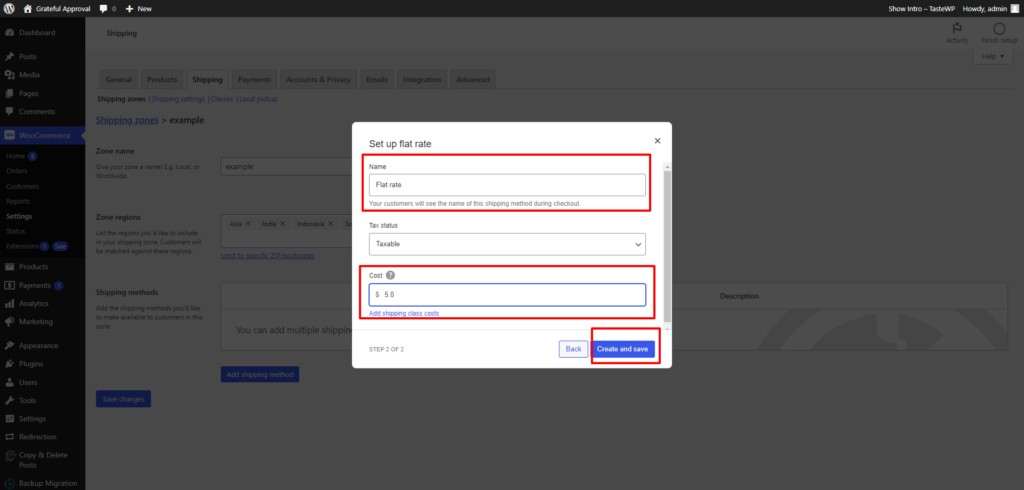
Setting up shipping rates in WooCommerce is a crucial aspect of your e-commerce business, as it directly impacts how much customers will be charged for shipping based on their location and the products they purchase. Here’s a comprehensive guide on how to set up shipping rates in WooCommerce:
1. Navigate to Shipping Methods:
Begin by logging into your WordPress dashboard and accessing the WooCommerce settings. Once you’re in the WooCommerce settings menu, click on the “Shipping” tab. This will take you to the settings page where you can configure all aspects related to shipping.
Within the Shipping settings page, you’ll find a list of shipping zones you’ve previously set up. Click on the specific shipping zone where you want to configure shipping rates. For example, if you have a zone named “Domestic,” click on it to access its settings.
2. Enable the Method:
Once you’re inside the shipping zone settings, you’ll see various shipping methods listed, such as Flat Rate, Free Shipping, or Local Pickup. Choose the specific shipping method you want to configure rates for, such as Flat Rate.
To enable the shipping method, simply check the box next to its name. This indicates that you’ll be using this method to calculate shipping rates for the selected zone. Enabling the method allows you to proceed with configuring the rates.
3. Configure Rates:
After enabling the shipping method, you’ll need to configure the rates based on your business requirements. Depending on the method chosen, you’ll have different options for configuring rates:
- Flat Rate: Set a fixed shipping cost for all orders within the zone. Enter the flat rate amount in the provided field.
- Free Shipping: Offer free shipping for orders within the zone. Simply select the option for free shipping, and customers won’t be charged for shipping.
- Local Pickup: Allow customers to pick up their orders directly. If you’re offering local pickup as a shipping option, ensure that it’s configured correctly, including any pickup locations or instructions.
- Customized Rates: For more complex shipping scenarios, you can set up customized rates based on factors like product weight, order subtotal, or a combination of variables. WooCommerce provides options to set up tiered rates, where shipping costs vary depending on the order total or weight range.
For example, you can create different shipping rate tiers, such as:
$5 shipping for orders under $50
$7 shipping for orders between $50 and $100
Free shipping for orders over $100
You can also set rates based on product-specific conditions or shipping classes, giving you granular control over shipping costs.
4. Save Changes:
Once you’ve configured the shipping rates to your satisfaction, don’t forget to save your changes. Scroll to the bottom of the shipping method settings page and click on the “Save changes” button to apply the newly configured shipping rates.
By following these detailed steps, you can effectively set up shipping rates in WooCommerce, ensuring that your customers are charged accurately for shipping based on their location and the products they purchase. This customization allows you to create a tailored shipping strategy that meets the needs of your business and enhances the overall shopping experience for your customers.
Shipping Settings
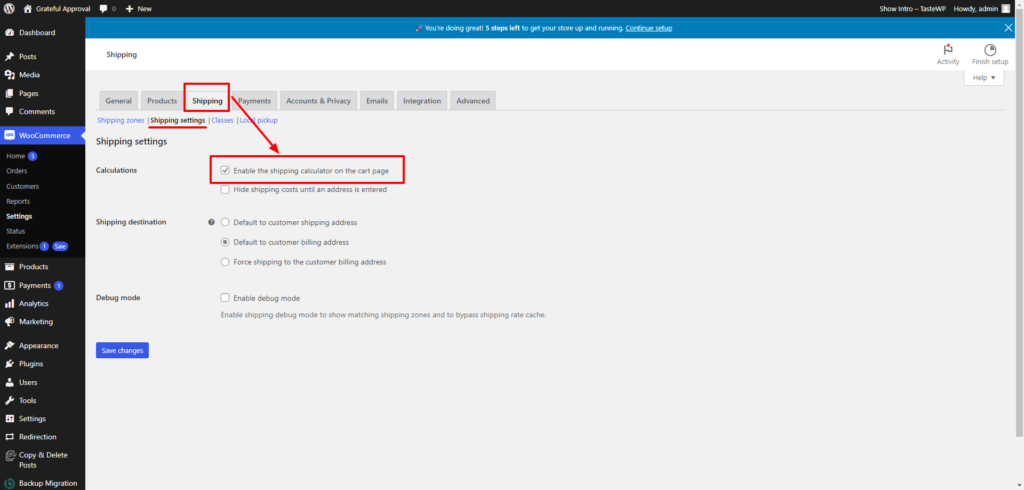
Configuring other essential WooCommerce Shipping Settings beyond Shipping Zones involves a series of crucial steps. These settings, including Shipping Calculations, Shipping Destination preferences, and Debug Mode, play a vital role in customizing the shipping experience for both merchants and customers. Let’s delve into the detailed steps for setting up these important WooCommerce Shipping Settings:
1. Shipping Calculations:
Shipping calculations determine how shipping costs are calculated and presented to customers. Here’s how you can set up shipping calculations in WooCommerce:
- Navigate to WooCommerce Settings:
Access your WordPress dashboard and click on the “WooCommerce” tab. From the dropdown menu, select “Settings.”
- Access the Shipping Tab:
Once in the WooCommerce Settings, click on the “Shipping” tab. This is the central hub for all your shipping-related configurations.
- Enable the Shipping Calculator on the Cart Page:
Inside the Shipping settings, locate the “Shipping Calculator” option.
Make sure the box labeled “Enable shipping calculator on cart page” is checked.
This will display a shipping calculator on the cart page, allowing customers to estimate shipping costs before proceeding to Woocommerce checkout page.
- Hide Shipping Costs Until an Address is Entered:
Find the “Shipping Options” section within the Shipping settings.
You can hide shipping costs by checking the box that says “Hide shipping costs until an address is entered”.
This setting ensures that shipping costs are only revealed once the customer provides their shipping address, reducing cart abandonment.
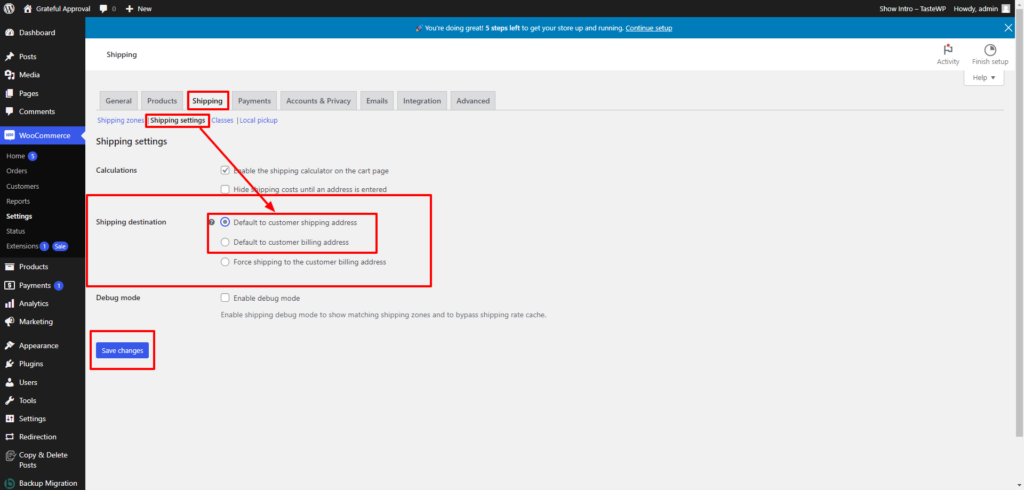
2. Shipping Destination:
Shipping Destination settings determine where WooCommerce should default the shipping information. Here are the steps to set up shipping destination preferences:
- Navigate to WooCommerce Settings:
As before, go to your WordPress dashboard, click on “WooCommerce,” and select “Settings.”
- Access the Shipping Tab:
Within WooCommerce Settings, click on the “Shipping” tab.
- Choose Shipping Destination Options:
Find the “Shipping Destination” section.
- Choose from the following options:
- Default to Customer Shipping Address: The system defaults to the customer’s shipping address.
- Default to Customer Billing Address: The system defaults to the customer’s billing address.
Force Shipping to the Customer Billing Address: Shipping is forced to the billing address, even if a separate shipping address is provided.
- Save Changes:
Once you’ve selected the preferred shipping destination option, save your changes to apply the settings.
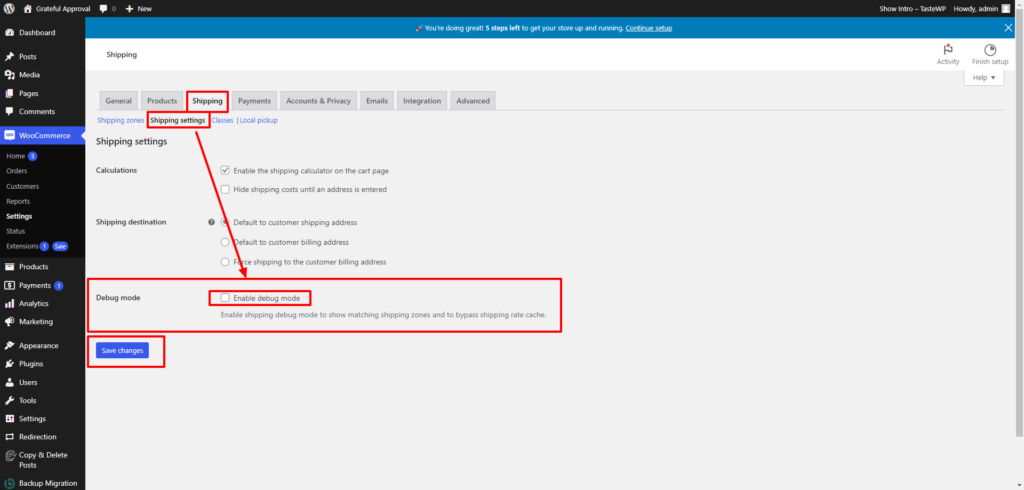
3. Debug Mode:
Enabling Debug Mode in WooCommerce is essential for troubleshooting and understanding the intricacies of shipping configurations. Here’s how to enable Debug Mode and Shipping Debug Mode:
- Navigate to WooCommerce Settings:
Access your WordPress dashboard, click on “WooCommerce,” and select “Settings.”
- Access the Advanced Tab:
Click on the “Advanced” tab within the WooCommerce Settings.
- Enable Debug Mode:
Locate the “Enable Debug Mode” checkbox.
Check this box to enable general debugging for WooCommerce. Debug mode helps in identifying and resolving various issues related to shipping and other aspects of your online store.
- Enable Shipping Debug Mode:
Below the general debug mode option, find “Enable shipping debug mode to show matching shipping zones and to bypass shipping rate cache.”
Check this box to enable shipping-specific debugging. This mode shows matching shipping zones during the checkout process and bypasses the shipping rate cache for accurate testing.
- Save Changes:
After enabling both debug modes, save your changes to activate debugging for your WooCommerce store.
Debug mode provides valuable information in the system status log, aiding merchants and developers in diagnosing any issues related to shipping calculations, zone assignments, or other shipping-related processes.
By following these detailed steps, merchants can successfully set up other crucial WooCommerce Shipping Settings, ensuring a smooth and optimized shipping experience for both the business and its customers. The customization options provided by these settings contribute to a more transparent and user-friendly online shopping environment.
Shipping Classes

Setting up Shipping Classes in WooCommerce is a valuable step for merchants who need to categorize their products based on specific shipping criteria. This feature allows for more accurate shipping calculations and customized shipping options for different types of products. Below is a detailed guide on how to set up Shipping Classes in WooCommerce:
1. Navigate to Shipping Classes:
Start by logging into your WordPress dashboard and accessing the WooCommerce settings. Once in the settings menu, locate and click on the “Shipping” tab. Within the shipping settings, you’ll find a sub-tab labeled “Shipping Classes.” Click on this tab to proceed to the Shipping Classes configuration page.
2. Add Shipping Class:
Upon accessing the Shipping Classes page, you’ll have the option to add a new shipping class. Look for the “+ Add Shipping Class” button, usually located at the top or bottom of the page, and click on it to create a new shipping class.
3. Name the Class:
After clicking the “Add Shipping Class” button, a dialogue box or form will appear, prompting you to enter details for the new shipping class. Start by giving the class a descriptive name that reflects the type of products it will apply to. For example, you might name it “Fragile” for delicate items that require special handling or “Standard” for regular products.
4. Configure Costs:
Once you’ve named the shipping class, the next step is to configure the shipping costs associated with products belonging to this class. Depending on your shipping strategy and business model, you may set specific costs or adjustments for products in this class. For instance, you might apply a higher shipping cost for oversized items or offer discounted shipping rates for lightweight products.
To configure costs for the shipping class:
- Flat Rate: Specify a fixed shipping cost that applies to all products in this class.
- Percentage Adjustment: Apply a percentage-based adjustment to the standard shipping cost for products in this class.
- Per-Item Rate: Set a shipping cost per item for products in this class.
Choose the option that best suits your pricing structure and shipping requirements. You can also leave the cost fields blank if you prefer to configure shipping costs at the product level.
5. Save Changes:
Once you’ve named the shipping class and configured the associated costs, don’t forget to save your changes. Look for a “Save Changes” button or similar option on the page, and click on it to ensure that your newly created shipping class is saved and applied.
By following these detailed steps, you can effectively set up Shipping Classes in WooCommerce, allowing you to categorize products based on specific shipping criteria and apply customized shipping costs or adjustments as needed. This functionality provides greater flexibility and control over your shipping strategy, ultimately enhancing the overall customer experience and optimizing your e-commerce operations.
Local Pickup
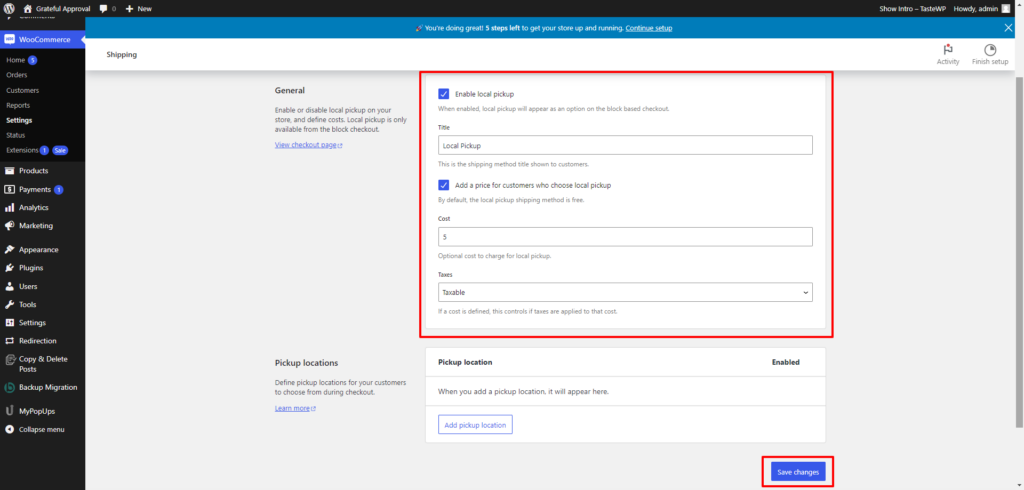
Setting up Local Pickup in WooCommerce is a valuable option for customers who prefer to collect their orders directly rather than waiting for delivery. This feature provides flexibility and convenience, enhancing the overall shopping experience. Here’s a detailed guide on how to set up Local Pickup in WooCommerce:
1. Enable Local Pickup:
To begin, log in to your WordPress dashboard and navigate to the WooCommerce settings. Within the settings menu, click on the “Shipping” tab. Here, you’ll find various shipping methods, including Local Pickup. Enable Local Pickup by ticking the checkbox next to it. This action activates the Local Pickup option for your customers during the checkout process.
2. Define Title and Costs:
Once Local Pickup is enabled, you can customize its title and specify any associated costs. Under the Local Pickup settings, you’ll see an option to input the title that will be displayed to customers at checkout. Choose a clear and descriptive title such as “Local Pickup” to indicate this shipping method.
By default, Local Pickup is often set to be free for customers. However, if you wish to charge a fee for this service, you can add a price for customers who choose Local Pickup. Simply enter the desired amount in the designated field. This fee could cover handling costs or serve as an additional revenue stream for your business.
3. Define Pickup Locations:
One of the essential aspects of setting up Local Pickup is defining pickup locations where customers can collect their orders. To do this, scroll down to the “Pickup locations” section within the Local Pickup settings. Here, you have the option to add one or multiple pickup locations.
- Add Pickup Location: Click on the “Add pickup location” button to create a new pickup location entry. A form will appear, allowing you to input details such as the location name, address, contact information, and any specific instructions or operating hours for customers.
- Enable Pickup Location: Ensure that the “Enabled” checkbox is ticked to make the pickup location available for selection during checkout. This step is crucial for activating the pickup option for customers.
- Save Changes: After adding the necessary details for each pickup location, remember to save your changes to apply the settings.
4. Customize Pickup Details:
To provide clarity and transparency to customers, it’s helpful to include additional information about Local Pickup on your website. You can customize the pickup details displayed to customers during the checkout process, providing clear instructions on how and when they can collect their orders.
Consider adding a brief description of the Local Pickup option on your checkout page, explaining the benefits and procedures for customers who choose this shipping method. You can also include any relevant terms and conditions regarding Local Pickup to ensure smooth transactions.
5. Test Checkout Process:
Once you’ve configured Local Pickup settings and added pickup locations, it’s essential to test and edit Woocommerce checkout page to ensure everything functions as expected. Place a test order on your website and select Local Pickup as the shipping method. Verify that pickup locations are displayed correctly, and customers can proceed with the pickup option seamlessly.
By following these detailed steps, you can successfully set up Local Pickup in WooCommerce, offering customers a convenient alternative for receiving their orders and enhancing the overall shopping experience on your e-commerce platform.
Conclusion
In conclusion, mastering the 5 Most Important WooCommerce Shipping Settings on your WordPress website is pivotal for elevating your e-commerce game. From strategically configuring Shipping Zones to fine-tuning Shipping Rates and harnessing the power of Shipping Classes, these settings provide the backbone for a seamless customer experience. Tailoring your shipping strategy with precision not only ensures cost-effective operations but also establishes trust and satisfaction among your customers. Also You can use some of the best Logistics WordPress themes that comes with number of functionalities which help you to make your website accessible to anyone.
The ability to navigate international shipping, estimate delivery times accurately, and offer local pickup options further solidifies your online presence. Embrace the potential of WooCommerce Shipping Settings to streamline operations, expand market reach, and ultimately propel your e-commerce venture to new heights. By understanding and implementing these settings effectively, you set the stage for a dynamic and customer-centric shipping approach that distinguishes your online store in the competitive world of e-commerce.


